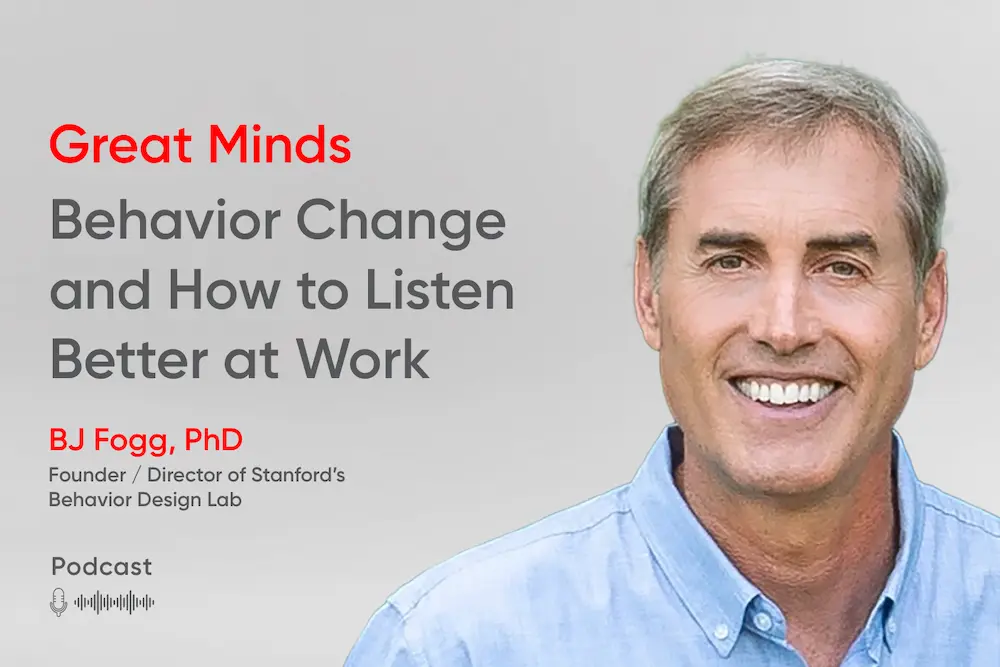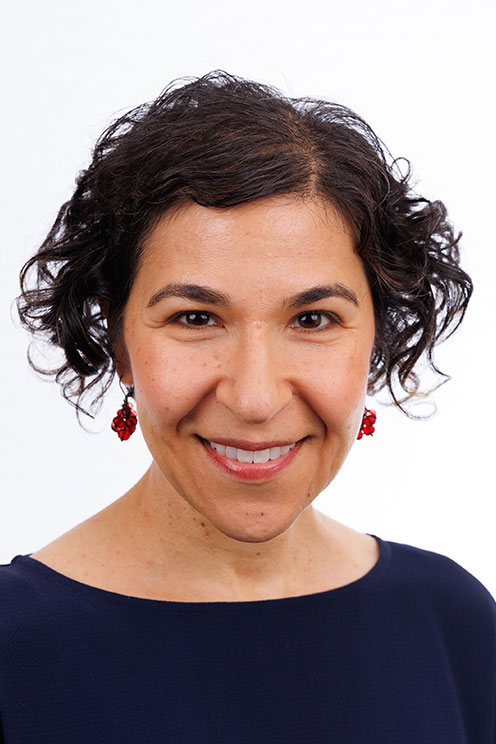On this episode of the Better podcast, Dr. BJ Fogg, founder and director of Stanford's Behavior Design Lab, and author of The New York Times bestseller, “Tiny Habits,” talks about how to change behavior in the workplace.
Podcast Highlights
- Behavior Change Model: Dr. Fogg explains that all behavior requires motivation, ability, and a prompt, similar to how fire needs fuel, air, and a spark. This model applies to both habits and one-time actions, such as persuading a leader.
- Listening as a Habit: While listening itself is an aspiration, Dr. Fogg suggests breaking it down into specific, repeatable behaviors. For instance, a habit like responding with “That’s interesting, tell me more” encourages deeper listening in workplace conversations.
- Persuading Leaders on Culture Initiatives: Fogg advises a mix of narrative and data to influence leaders. Compelling stories and concrete data together create a strong persuasive approach, especially when asking for a decision or approval on cultural initiatives.
- Small Check-ins for Busy Managers: For busy leaders, Fogg recommends quick, low-effort check-ins like sending a short message or a quick chat, which require minimal motivation but build strong connections with team members consistently.
He applies his behavior model to common workplace scenarios like listening better, making time to meet with your people, and persuading your boss to sign-off on a culture initiative.
He shares his favorite habits, and the No. 1 habit he recommends we all start today.
On what’s required for behavior change:
All behavior, including habits, which is a type of behavior, happens when there's motivation, ability, and a prompt. Those are the three components that come together.
It's kind of like fire needs three things. With fire, you need fuel, you need air, and you need a spark. If you're missing any of those things, the fire will not happen. And that's how to think about the behavior model.
On how leaders can become better listeners:
Listening is not a behavior. It’s more abstract, and so I call it an aspiration. There are behaviors that you do that will lead to better listening, and that's what you need to figure out.
Maybe one habit is after somebody shares something personal about themselves, I will say—and this is the habit, "That's interesting, tell me more." Then that is a behavior. That is a behavior you can turn into a habit.
At Stanford with my students, I ask a question and if nobody speaks up, there's this time of nervousness and you want to fill the space, but the habit is to just let it be empty and let them respond.
In the Tiny Habits method, what you do is you find the best ones for you. And that's a combination of number one, will it be impactful? Will it be effective at, in this case, helping me become a good listener in the workplace?
And number two, is it something I can get myself to do? Can I get myself to, at the beginning of every meeting, do some sort of check-in where I listen? Can I get myself to actually pause for a few seconds after I ask a question? It’s that combination—what's going to be effective and what can I get myself to do.
On how to get a leader to commit to culture work:
You're not trying to get the CEO to create a habit. You're trying to get the CEO to make a decision or to approve something, which is a one-time action. That's a different project than designing for a habit. Now, both habits and one-time actions will come down to motivation, ability, and prompt, because they're behaviors.
The best way to persuade is a combination of narrative and data. Tell a very compelling story or have them consume a very compelling story. TED Talks do this very well. It might be a TED Talk, it might be somebody from another company, it might be somebody within the company.
And also data. Here's what the data shows. Those work differently in people's brains and both of them can be very persuasive, and together they're very powerful. Present narrative and data. and then the behavior you want, and make it really easy to do.
On helping busy managers find time to check-in with their people:
Even though you may have a check-in that's a 30-minute meeting, scale it back and say, "What is the simplest thing I can do with the most impact?" It might be sending a text, sending an emoji, a five-minute chat on the way home, in the car or something like that.
Here’s why: The easier, simpler behavior, the less motivation it takes to do the behavior. So if your motivation is going out to other things in the moment, if something's really easy to do, you can still do it. If something's hard, like it takes an hour or it takes a lot of thinking or a lot of creativity, then when your motivation sags, you don't do it.
On his favorite habit:
One is first thing in the morning, and I've named this the Maui Habit, and I even gave a TED Talk on it, is as soon as your feet touch the floor in the morning and you’re getting out of bed, you say, "It's going to be a great day." It really improves your morning, your day, your week, your life, and so on.
Another great time to put in habit is after you turn on the shower and you're waiting for it to get warm, you can have a moment of gratitude. For me, the practice is gratitude around some aspect of my body and I try to look for really unusual ones. One of my friends started doing pull-ups. He put a pull-up bar in his bathroom and would do at least one pull-up.
The expectation in the Tiny Habits method is, "I'll do at least one, and if I want to do more, I'll do more." And he got stronger and started doing a lot more, and he was so happy about that. And it was in those few seconds when you're waiting for the shower to warm up, you do something and the consistency pays off over time.
FAQs
- How can I apply the behavior change model at work?
Identify a behavior, ensure you have motivation, ability, and a prompt. For example, set a 5-minute follow-up right after meetings to reinforce the habit. - What actions can make me a better listener?
Use small habits like saying, “That’s interesting, tell me more,” to encourage others to share more, helping you actively listen. - How do I persuade my boss to support a culture initiative?
Combine a compelling story with supporting data. This mix appeals to both emotion and logic, making a stronger case. - How can I find time for check-ins with my team?
Keep check-ins simple, like a quick text or short chat, to make them easy and sustainable, even with a busy schedule.
Tools & Resources
- Company Culture: Building a strong company culture begins with trust, flexibility, and employee engagement. Learn how to create an inclusive and high-performing culture that resonates with your workforce by exploring our resources.
- Employee Engagement: Employee engagement is driven by providing flexibility and opportunities for meaningful work. Discover strategies to enhance engagement in your organization with our expert insights.
- Leadership & Development: Leadership plays a critical role in building trust and driving employee success. Explore how to develop strong leaders who foster collaboration, innovation, and engagement with our programs.
- Diversity and Inclusion: A diverse and inclusive workplace strengthens employee trust and contributes to long-term success. Learn how to create a more equitable environment through our initiatives.
Feedback
Your feedback matters! We’re committed to providing practical insights, and we’d love to hear how this episode resonated with you. Did Dr. BJ Fogg’s strategies help you think differently about behavior change or active listening at work? Is there something specific you’d like us to dive deeper into? Share your feedback or suggestions with us, and together, we’ll continue creating valuable resources to support your growth. Have feedback? Let us know by filling out this form—click here.
Get Certified 
Think your company is a Great Workplace? Get certified today to make it onto our best workplaces lists.
Original Podcast Published by Great Place To Work® USA : Click here to visit the page.







